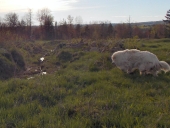The below link provides technical details on planning for water movement in large earth projects. This would apply particularly to dams (preventing failure due to internal erosion) but also to other earthworks affected by water flow - ie. most of them. Published by the Bureau of Reclamation in 2011. Many engineers have given a _lot_ of thought to preventing silt run-off in/around dams and highways - they want to keep stuff where they put it, and/or where it lies naturally, and keep it there for very long periods of time; they're quite motivated because the costs of serious maintenance or failure are huge. Besides problems caused by its loss or movement, silt often plugs up the pores of material that would otherwise drain (allow water movement through it) where upon the water finds/makes another more destructive path. One conclusion becoming more well accepted lately seems to be that geotextile filter fabric often doesn't work very well because silt can plug it up and renders it impervious w/in 3-5 years.
Regarding whether this info may not relate because it's aimed at big huge projects, I can only say that I came by it looking for solutions to the same problem for a small french drain in my back yard... However, the publication lays out a very complex subject, albeit in plain English with a minimum of math, and it's nothing but details. It's all understandable but... you gotta love detail.
My take away was that discovering the specific properties of the material on your site and then making a plan and determining the properties of additional material you need to provide good water/erosion control is more than worth the trouble if you're doing something large or even something small that you hope will sustain for the next generation. It seems like that may be possible...
http://www.usbr.gov/pmts/tech_services/engineering/design/DS13-5.pdf
For those wanting more info and explanation I found the following site good for various technical topics in (more or less) layman's terms:
http://www.eng-tips.com
Rufus










